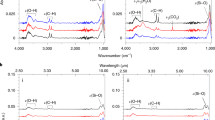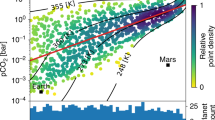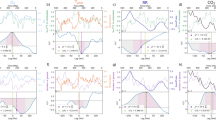Abstract
The low temperatures1,2 and high ultraviolet radiation levels3 at the surface of Mars today currently preclude the survival of life anywhere except perhaps in limited subsurface niches4. Several ideas for making the Martian surface more habitable have been put forward5,6,7,8, but they all involve massive environmental modification that will be well beyond human capability for the foreseeable future9. Here, we present a new approach to this problem. We show that widespread regions of the surface of Mars could be made habitable to photosynthetic life in the future via a solid-state analogue to Earth’s atmospheric greenhouse effect. Specifically, we demonstrate via experiments and modelling that under Martian environmental conditions, a 2–3 cm-thick layer of silica aerogel will simultaneously transmit sufficient visible light for photosynthesis, block hazardous ultraviolet radiation and raise temperatures underneath it permanently to above the melting point of water, without the need for any internal heat source. Placing silica aerogel shields over sufficiently ice-rich regions of the Martian surface could therefore allow photosynthetic life to survive there with minimal subsequent intervention. This regional approach to making Mars habitable is much more achievable than global atmospheric modification. In addition, it can be developed systematically, starting from minimal resources, and can be further tested in extreme environments on Earth today.
This is a preview of subscription content, access via your institution
Access options
Access Nature and 54 other Nature Portfolio journals
Get Nature+, our best-value online-access subscription
$29.99 / 30 days
cancel any time
Subscribe to this journal
Receive 12 digital issues and online access to articles
$119.00 per year
only $9.92 per issue
Buy this article
- Purchase on Springer Link
- Instant access to full article PDF
Prices may be subject to local taxes which are calculated during checkout





Similar content being viewed by others
Data availability
The data that support the plots within this paper and other findings of this study are available from the corresponding author upon reasonable request.
Code availability
The one-dimensional solid-state greenhouse numerical model is available open source at https://github.com/wordsworthgroup/Mars_SSG_2019.
References
Martínez, G. M. et al. The modern near-surface Martian climate: a review of in-situ meteorological data from Viking to Curiosity. Space Sci. Rev. 212, 295–338 (2017).
Forget, F. et al. Improved general circulation models of the Martian atmosphere from the surface to above 80 km. J. Geophys. Res. 104, 24155–24176 (1999).
Cockell, C. S. et al. The ultraviolet environment of Mars: biological implications past, present, and future. Icarus 146, 343–359 (2000).
Michalski, J. R. et al. The Martian subsurface as a potential window into the origin of life. Nat. Geosci. 11, 21–26 (2018).
Allaby, M. & Lovelock, J. The Greening of Mars (Deutsch, 1984).
McKay, C. P., Toon, O. B. & Kasting, J. F. Making Mars habitable. Nature 352, 489–496 (1991).
Zubrin, R. & McKay, C. Technological requirements for terraforming Mars. 29th Joint Propulsion Conference and Exhibit AIAA-93-2005 (American Institute of Aeronautics and Astronautics, 1993).
Gerstell, M. F., Francisco, J. S., Yung, Y. L., Boxe, C. & Aaltonee, E. T. Keeping Mars warm with new super greenhouse gases. Proc. Natl Acad. Sci. USA 98, 2154–2157 (2001).
Jakosky, B. M. & Edwards, C. S. Inventory of CO2 available for terraforming Mars. Nat. Astron. 2, 634–639 (2018).
Hapke, B. A model of radiative and conductive energy transfer in planetary regoliths. J. Geophys. Res. 101, 16817–16831 (1996).
Kieffer, H. H., Christensen, P. R. & Titus, T. N. CO2 jets formed by sublimation beneath translucent slab ice in Mars’ seasonal south polar ice cap. Nature 442, 793–796 (2006).
Pilorget, C., Forget, F., Millour, E., Vincendon, M. & Madeleine., J. B. Dark spots and cold jets in the polar regions of Mars: new clues from a thermal model of surface CO2 ice. Icarus 213, 131–149 (2011).
Kaufmann, E. & Hagermann, A. Experimental investigation of insolation-driven dust ejection from Mars’ CO2 ice caps. Icarus 282, 118–126 (2017).
Niederdorfer, E. Messungen des Wärmeumsatzes über schneebedecktem Boden. Meteorol. Z. 50, 201–208 (1933).
Brown, R. H. & Matson, D. L. Thermal effects of insolation propagation into the regoliths of airless bodies. Icarus 72, 84–94 (1987).
Lide, D. P. (ed.) CRC Handbook of Chemistry and Physics 81st edn (CRC Press, 2000).
Dorcheh, A. S. & Abbasi, M. H. Silica aerogel; synthesis, properties and characterization. J. Mater. Process. Tech. 199, 10–26 (2008).
Schultz, J. M., Jensen, K. I. & Kristiansen, F. H. Super insulating aerogel glazing. Sol. Energy Mater. Sol. Cells 89, 275–285 (2005).
Novak, K. S., Phillips, C. J., Birur, G. C., Sunada, E. T. & Pauken, M. T. Development of a thermal control architecture for the Mars Exploration Rovers. AIP Conf. Proc . 654, 194–205 (2003).
Fairén, A. G., Davila, A. F., Gago-Duport, L., Amils, R. & McKay, C. P. Stability against freezing of aqueous solutions on early Mars. Nature 459, 401–404 (2009).
Meador, M. A. B. et al. Cross-linking amine-modified silica aerogels with epoxies: mechanically strong lightweight porous materials. Chem. Mater. 17, 1085–1098 (2005).
Randall, J. P., Meador, M. A. B. & Jana, S. C. Tailoring mechanical properties of aerogels for aerospace applications. ACS Appl. Mater. Interfaces 3, 613–626 (2011).
Nixon, S., Cousins, C. R. & Cockell, C. Plausible microbial metabolisms on Mars. Astron. Geophys. 54, 13–16 (2013).
Stern, J. C. et al. Evidence for indigenous nitrogen in sedimentary and aeolian deposits from the Curiosity rover investigations at Gale crater, Mars. Proc. Natl Acad. Sci. USA 112, 4245–4250 (2015).
Mustard, J. F., Cooper, C. D. & Rifkin, M. K. Evidence for recent climate change on Mars from the identification of youthful near-surface ground ice. Nature 412, 411–414 (2001).
Plaut, J. J. et al. Radar evidence for ice in lobate debris aprons in the mid-northern latitudes of Mars. Geophys. Res. Lett. 36, L02203 (2009).
Dundas, C. M. et al. Exposed subsurface ice sheets in the Martian mid-latitudes. Science 359, 199–201 (2018).
Kahre, M. A., Murphy, J. R. & Haberle, R. M. Modeling the Martian dust cycle and surface dust reservoirs with the NASA Ames general circulation model. J. Geophys. Res. 111, E06008 (2006).
Schulze-Makuch, D., Fairén, A. G. & Davila, A. Locally targeted ecosynthesis: a proactive in situ search for extant life on other worlds. Astrobiology 13, 674–678 (2013).
Aizenberg, J. et al. Skeleton of Euplectella sp.: structural hierarchy from the nanoscale to the macroscale. Science 309, 275–278 (2005).
Kröger, N. & Poulsen, N. Diatoms—from cell wall biogenesis to nanotechnology. Annu. Rev. Genet. 42, 83–107 (2008).
Parkinson, J. & Gordon, R. Beyond micromachining: the potential of diatoms. Trends Biotechnol. 17, 190–196 (1999).
Nassif, N. & Livage, J. From diatoms to silica-based biohybrids. Chem. Soc. Rev. 40, 849–859 (2011).
Rummel, J. D., et al. A new analysis of Mars ‘special regions’: findings of the second MEPAG Special Regions Science Analysis Group (SR-SAG2). Astrobiology 14, 887–968 (2014).
Dong, X., Sun, Z., Nathan, G. J., Ashman, P. J. & Gu, D. Time-resolved spectra of solar simulators employing metal halide and xenon arc lamps. Sol. Energy 115, 613–620 (2015).
Fu, T., Tang, J., Chen, K. & Zhang, F. Visible, near-infrared and infrared optical properties of silica aerogels. Infrared Phys. Technol. 71, 121–126 (2015).
Barlow, R. J. Statistics: a Guide to the Use of Statistical Methods in the Physical Sciences, Vol. 29 (Wiley, 1989).
Matson, D. L. & Brown, R. H. Solid-state greenhouse and their implications for icy satellites. Icarus 77, 67–81 (1989).
Pierrehumbert, R. T. Principles of Planetary Climate (Cambridge Univ. Press, 2011).
Macdonald, F. A. & Wordsworth, R. Initiation of Snowball Earth with volcanic sulfur aerosol emissions. Geophys. Res. Lett. 44, 1938–1946 (2017).
Hartmann, D. L. Global Physical Climatology, Vol. 103 (Newnes, 2015).
Prussing, J. E. & Conway, B. A. Orbital Mechanics (Oxford Univ. Press, 1993).
Levine, J. S., Kraemer, D. R. & Kuhn, W. R. Solar radiation incident on Mars and the outer planets: latitudinal, seasonal, and atmospheric effects. Icarus 31, 136–146 (1977).
Clifford, S. M. A model for the hydrologic and climatic behavior of water on Mars. J. Geophys. Res. 98, 10973–11016 (1993).
Author information
Authors and Affiliations
Contributions
All authors discussed the experimental and numerical results and contributed to a draft version of the manuscript. R.W. proposed the solid-state greenhouse habitability idea, performed the experiments and wrote much of the manuscript. L.K. helped to write the sections on site selection on Mars and silica aerogel properties, and compiled data on the evidence for subsurface water sources. C.C. provided input on the nutrient, UV and pressure constraints on Martian habitability and on the ethical considerations.
Corresponding author
Ethics declarations
Competing interests
The authors declare no competing interests.
Additional information
Peer review information: Nature Astronomy thanks Joshua Bandfield, Dirk Schulze-Makuch and the other, anonymous, reviewer(s) for their contribution to the peer review of this work.
Publisher’s note: Springer Nature remains neutral with regard to jurisdictional claims in published maps and institutional affiliations.
Supplementary information
Supplementary Information
Supplementary Tables 1–2, Supplementary Figs. 1–5.
Rights and permissions
About this article
Cite this article
Wordsworth, R., Kerber, L. & Cockell, C. Enabling Martian habitability with silica aerogel via the solid-state greenhouse effect. Nat Astron 3, 898–903 (2019). https://doi.org/10.1038/s41550-019-0813-0
Received:
Accepted:
Published:
Issue Date:
DOI: https://doi.org/10.1038/s41550-019-0813-0
This article is cited by
-
Microbial applications for sustainable space exploration beyond low Earth orbit
npj Microgravity (2023)
-
Hygroscopic holey graphene aerogel fibers enable highly efficient moisture capture, heat allocation and microwave absorption
Nature Communications (2022)
-
How elastic moduli affect ambient pressure drying of poly(methylsilsesquioxane) gels
Journal of Sol-Gel Science and Technology (2022)
-
Tracing a modern biosphere on Mars
Nature Astronomy (2021)
-
Plasmon-induced transparency sensor for detection of minuscule refractive index changes in ultra-low index materials
Scientific Reports (2021)



